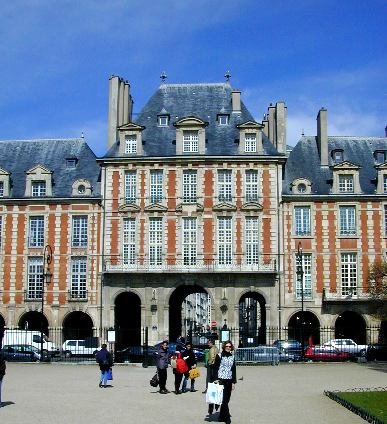Paris 4-4-2000
Mus�e National du Moyen Age
You can talk about museums for hours at a time, but until you really GO to the one in question, you do not get a feel for it. This morning we went to the Musee de Cluny (No, not George Cluny, but I though that may have been the case) to see the Mus�e National du Moyen Age. (I have not figured out the difference between �de� and �du�. I think that they randomly change the article just to make the language more difficult than it need be. Spanish only has ONE word for �of� and that is �de�. I know that Portuguese has two � but I was never able to master that either.) Some of you may know that Doreen�s specialty in college was Medieval Manuscripts. Well, let me tell you what. We went to the right place. It is really a joy to be in a museum like that with a person like that. (Well, quite frankly, it is a joy to be with her in ANY museum. Or anywhere else, for that matter, but now I am getting a little too personal for this story.) She understands context as well as content can read the French inscriptions, and generally loves all the cool stuff we see.
The Cluny was an old Roman bathhouse. It is the last Roman bathhouse extant with a roof in Paris. You go UP the stairs and it is warm. You go DOWN the stairs and it is cold. They have windows from Ste Chappelle (which see) and the �Heads of the Kings of Judea� They have illustrated pages, they have tapestries. There seems to have been a whole INDUSTRY making Unicorn tapestries. I didn�t take any pictures, but you would recognize these tapestries. They are amazing bits of workmanship. I guess that they kept the rooms warm, too.
In another room they had just a ton of Medieval Ivory. We found a store where you could by such things (Museum quality, as well) but were stunned by what we saw in the Cluny. You can see why people like this material. It looks almost alive, and when you touch it, it FEELS almost alive. (Now don�t get me wrong � I am not at all in favor in lifting the ban on new ivory. But like fur coats, you can understand the visceral appeal of such a material.)
The Paris museums, unlike the London museums, all have an entrance fee. Some of the fees are not insubstantial. They do sell multi-day passes to the bulk of the museums, however, which has the added benefit of skipping you to the head of the line. We bought a five day pass at the Cluny (which had no line) and when we left this museum, headed over to the Louvre.
The Louvre
The Louvre is everything you can imagine a museum to be. It was at one time a palace, and when you walk in, you can understand how the French Revolution started. I mean, if people were LIVING in that place, and others could not get enough bread to eat, there SHOULD have been a revolution. (Interesting side line here. Why was the French Revolution so much different than the American Revolution? We had no Terror. We had no wholesale slaughter. We had a government that is still, in essence, in power today. What happened here?)
I decided (Like a good tourist) that we should see the Mona Lisa on our first trip. That coincided nicely with Doreen�s wishes, since she likes to see the Italian wing. Wing, well, that is the wrong thing to call it. There are thousands of paintings, laid out along hallways where you could play football. We spent HOURS walking through an amazing number of beautiful paintings (and others as well) before we even came close to the DaVinci paintings. (NB: There are other paintings as beautiful as the Mona Lisa. There are others MORE beautiful, but if you don�t see Mona while here, you miss a meme � you miss the ability to say �It was nice, but�� I will say it was stunning, but no more stunning than other Leonardo�s that were down the hall, with no people standing around videotaping (!) the picture. (Doreen had a great comment today while in the D�Orsey. More people were videotaping, and she said: �Can you imagine anything MORE boring that seeing someone�s videotape of an art museum?� Especially when the woman we were behind at the time, videotaping a Van Gogh self portrait, said �Now this is a self portrait right?�)
We spent several hours, and will go back again later this week to see something besides the Italians, and the few French Large Scale Paintings we saw (Liberty leading the people. You all know this one, as well).
From the Louvre we decided to go walking in Ste Germain de Pres, a wonderful Rive Gauche neighborhood. We stopped in at a print seller where we had ALMOST bought a Picasso print before, but found nothing of interest. We had a light lunch in the neighborhood, and then walked over to the Luxembourg Gardens.
The Luxembourg Gardens
They have a funny idea about green spaces here in Paris. Mainly, they are not so green. There is not much grass on the ground, and where there IS grass, it is mostly decorative. I guess that all that gravel is easier to clean, but it makes for a funny sort of park. The trees too, must be well behaved. They are all square- chopped on the top as well as the sides. Very orderly. It is funny to see hundreds of people out and about is these somewhat (to my mind) Spartan surroundings. But they love it, and you can tell that they love it. There are men playing chess, playing cards. There are kids renting miniature sailboats to float in the fountain. Overall a delightful place (ignoring the lack of grass) to spend several leisurely hours.
This day we also visited the Pantheon and the church of St Etienne du Mont. The Pantheon was oddly secular in a ecclesiastical building, because it had been started before the Revolution, and then turned into a �Monument to Man and Rationality� by the godless revolutionaries. Interred in the building are Volitaire (which see) Hugo, and Rousseau. Rousseau�s crypt has his arm creeping out of the side carrying a torch. A light of reason, I think it was. The Curies are also buried there. They warn you to not get too close to those crypts, as they may still be radioactive (well, not really. Makes a good story, though.)
SEdM was depressing because the revolutionaries had dug out Ste Genevive�s body, burned it, and threw it into the Seine. They were not too nice. There had recovered only a stone from her tomb, and had it in a reliquary. Sad. Pascal and Racine were buried in this church.
The Top of Notre Dame
I walked to the top of Notre Dame. It is a long way (386 steps, according to one of the guidebooks) but no worse than the other churches I have walked to the top of. As a matter of fact, this one was somewhat easier, as the lower steps (the ones below the towers � the first 261 steps) are much wider than other steps I have ascended. The view at the top was well worth the hike. As I was descending, I told one of the guards that I was too old for this. She said that there are 80 year old couples who come up everyday. I am not sure I believe here, but I did see one old man, somewhat crippled, holding his ears and going �The Bells! The Bells!�.
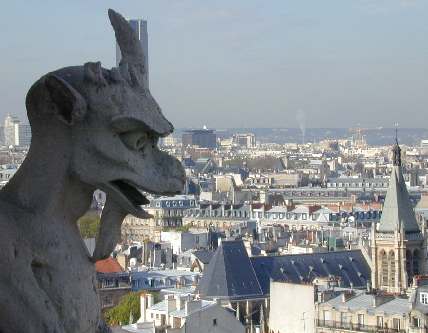
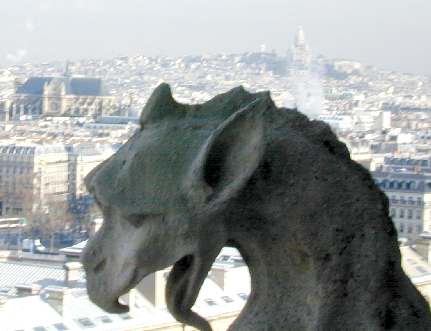
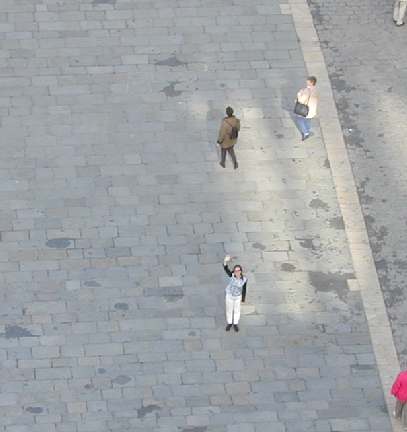
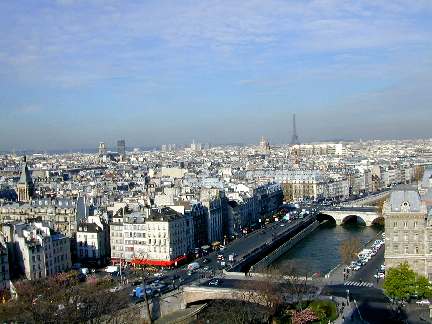
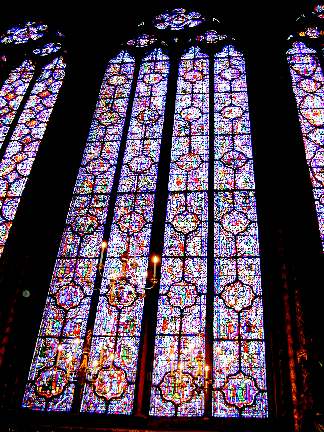
Ste Chappelle
After Notre Dame, we walked over to Ste Chappelle, a church built as a reliquary for Christ�s Crown of Thorns, and fragments of the True Cross. (Those are now in the treasury of Notre Dame). It is some of the most amazing stained glass that you will ever see. Each window tells a different biblical story, and the windows are all about 50 feet high.
I have been wanting to eat something called Oeufs en Croquette since I came to Paris the first time, and saw them in a guide book. They are listed as one of the common foods in the Bistros, but I have NEVER seen them on a menu. So for lunch, we tried to find Oeufs en Croquette, informally known as �Eggs in a bucket�
Mus�e D�Orsey
We left the Iles, and headed over towards the Mus�e D�Orsey, hoping to find Eggs in a Bucket along the way. We thought we ran into something similar at the Caf� Voltaire (located in the building where Voltaire died) but had no luck. I had to eat Quiche Lorraine (Not bad, but not much of a substitute for Eggs in a Bucket) Doreen had to eat Roast Chicken with no seasonings. I think that is a Rive Gauche special.
Across the street from the Caf� Voltaire is the Museum. It is in an old train station, in a space that could have been soaring, but they designed it so that it is only oppressive. The old parts of the building are beautiful, but the 1970s structure is as deflating as an old railroad station is inviting. This is not to take away from the art. You have pieces here, again, that you will recognize. Whistler�s Mother. The little dancer. Doctor Paul Gachet. The Thinker. Even if you don�t recognize the names (Whistler�s mother is really called �A Study in Grey and Black�) you would recognize the art. It has become part of all of us. I think that is the main reason that I wanted to come to Paris. To see these things first hand that we have only seen in books before.
